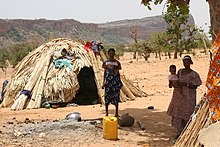
Ibrahim Boubacar Keïta, often known by his initials IBK, was a Malian politician who served as the president of Mali from September 2013 to August 2020, when he was forced to resign in the 2020 Malian coup d'état. He served as Mali's prime minister from February 1994 to February 2000 and as president of the National Assembly of Mali from September 2002 to September 2007.

Soumeylou Boubèye Maïga was a Malian politician who was the Prime Minister of Mali between 30 December 2017 and 18 April 2019. The leader of the Alliance for Solidarity in Mali, he had previously served in the government of Mali as Minister of Foreign Affairs under President Amadou Toumani Touré from 5 April 2011 until the March 2012 coup d'état. Later he was Minister of Defense from 2013 to 2014 and was Secretary-General of the Presidency from 2016 to 2017.
The Azawad conflict has been a conflict in Northern Mali between the MNLA, a Tuareg nationalist group, and a coalition of Islamist groups. The conflict began when Northern Mali declared itself independent from the government, creating the unrecognized state of Azawad. The Islamists and MNLA formed an alliance in combatting the Malian government. An internal conflict sprung up over the imposing of sharia law in the new state and the MNLA distancing itself from the coalition to a democratic state. Islamists gained popularity amongst anti-Tuareg tribes which helped them overthrow MNLA authority in Gao. Both sides clashed repeatedly leading to the Battle of Gao, where the MNLA were driven from the North's two main cities, Gao and Timbuktu. The MNLA soon lost all of its strongholds in the North in a matter of months. They went into hiding secretly gaining support and strength. The beginning of 2013 led to the start of the French intervention in Mali that ousted the Islamists from the North's cities and brought back Malian authority. The MNLA supported the French and Chadian forces in military operations against Islamists' sanctuaries in the mountains. The MNLA recaptured several important towns in the Kidal Region but refused to disarm or hand them over to the Malian government. A series of Islamist-sponsored terror attacks plagued MNLA forces for siding with the French. Checkpoints and bases were targeted with suicide bombings that targeted MNLA members. A peace deal was reached with the Malian army in June that let the army transverse freely in MNLA-occupied zones that were under Malian jurisdiction. Ethnic violence sprung over the murder of a Tuareg Government officer's family. The MNLA responded by harassing and murdering Fulani civilians, who constitute a majority of Islamist rebels. The Islamists stepped up their attacks in one such instance massacring 30 Tuareg merchants. The MNLA has since been battling Islamists.
The 2016 Nampala attack was an armed assault against a Malian Army base in the Niono Cercle subdivision of the Ségou Region of Mali on 19 July 2016, that left at least 17 government soldiers dead and 35 others injured. The Katiba Macina, al-Qaeda in the Islamic Maghreb and the ethnic Fula militant group National Alliance for the Protection of Fulani Identity and the Restoration of Justice (ANSIPRJ) claimed joint responsibility.

Amadou Koufa, nom de guerre of Amadou Diallo, also spelled Hamadoun Kouffa or Amadou Kouffa is a Malian Fulani jihadist and preacher who founded Katiba Macina, later part of Jama'at Nasr al-Islam wal Muslimin.
Events in the year 2019 in Mali.
Dan Na Ambassagou is an ethnic Dogon militia in Mali. The militia was setup in 2016 to defend Dogon communities against attacks, which has led to a number of conflicts with members of the Fula community. They accuse the Fula of sympathizing with or sheltering Islamist militants in their villages. They are run by Youssouf Toloba.
On 10 June 2019, the Dogon village of Sobane Da in Mali was attacked. Moulaye Guindo, mayor of neighbouring Bankass, blamed a Fulani militia group. The attack killed 35 people, revised from an earlier claim of 95 killed with 19 missing. A survivor said the attackers numbered about 50, driving motorbikes and pickup trucks. The government of Mali has suspected that terrorists have committed the attack.
Events in the year 2021 in Mali.
The Moura massacre was carried out by Malian Armed Forces and Russian mercenaries from the Wagner Group between 27 and 31 March 2022, in the central Malian town of Moura, Mopti Region in conflict with Al-Qaeda in the Islamic Maghreb's Jama'at Nasr al-Islam wal Muslimin. Over 300 civilians are alleged to have been killed according to US-based Human Rights Watch.

An Islamist insurgency has been ongoing in the Sahel region of West Africa since the 2011 Arab Spring. In particular, the intensive conflict in the three countries of Mali, Niger and Burkina Faso has been referred to as the Sahel War.
On 18 and 19 June 2022, 132 civilians were killed by Islamist insurgents in Bankass Cercle, Mopti Region, Mali.
Events in the year 2022 in Mali.
On June 17, 2019, ethnic Fulani militiamen attacked Dogon civilians in the villages of Gangafani and Yoro, in Koro Cercle, Mali, killing 41 people.
The Koulogon massacre took place on January 1, 2019, in a Fulani village near the town of Koulogon Habbé, Bankass Cercle, Mali.
On April 21, 2019, Jama'at Nasr al-Islam wal Muslimin attacked a Malian military base at Guiré, Mali, as revenge for the Ogossagou massacre.
On February 6, 2014, between thirty-one and thirty-five Imghad Tuareg civilians were massacred by Fulani militants that may have been connected to the jihadist outfit Movement for Oneness and Jihad in West Africa (MOJWA) in and around Tamkoutat, Ménaka Region, Mali.
On July 1, 2020, Fulani militants attacked four Dogon villages in Mali's Bankass Cercle, killing at least thirty-three people.






